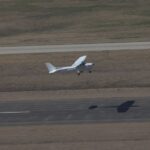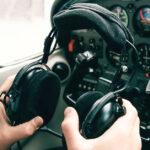By Tim Genc
It is widely accepted that in theory – his iPhone was still on Spain-time, so we’re not exactly sure – Christopher Columbus sighted and landed in the Bahamas in mid-October, 1492. He navigated across the Atlantic and found an island he named San Salvador, thus marking the first discovery of the New World since its previous discovery by Norse explorers who discovered it after its then-current inhabitants.
In order to answer the question, “how to become a pilot”, there may be a few things one can glean from another forerunning navigator: Christopher Columbus. There was life and land across the great ocean, another side of the world beyond the horizon; the world was navigable, and an age right with the exploration and colonization of the world began, using little more than a compass and some good ole’ fashion dead reckoning.
October 12th – one of the agreed upon possible dates of Columbus’s arrival at San Salvador – is Columbus Day. Not until the space program of the mid-20th century, and not since the first of early-man decided that some dinosaurs outside the cave door were vegetarians had there ever been a journey into more of an unknown, and with so little sound data, than Columbus’s crossing of the Atlantic. Therefore, it only makes sense that in this month’s issue of Pilot’s Digest, we not only celebrate one of the earliest explorers, but that we also take the time to recognize that we, as pilots, are the current generation of adventurers and trailblazers, often departing on similarly exciting journeys and having to make some of the same decisions. Taking this a step further, let’s highlight some of the elements and decisions we are faced with during our exploration of the New World/local airport that lies a daunting 100NM away.
Do your planning beforehand. Columbus had calculated (incorrectly) that the circumference of the Earth was significantly smaller than accepted, and that is one of the reasons he was set on making the voyage. Had he listened to others who had determined the distance differently, he might have made a different decision. It is imperative that all of us review the route and become familiar with all of the information concerning the proposed flight before departing. Otherwise, we may run into closed airports, out-of-service navigation equipment, TFRs or legions of indigenous people that will need to be “displaced”.
Document your planning. Christopher Columbus was one of the first explorers to document his navigation methodology and calculations; thank goodness, because much of what we know about his journey is because of this route and planning log. Keep in mind, however, that we’re probably not the only people who have re-read his written recount of his voyage – he was doing so as well!
Analyzing what you’ve done before and using it to influence what you will do in the future is a huge part of learning. That includes keeping that route log as you fly your cross-country adventures; all of those boxes about true airspeed, true course, WCA and magnetic variation, they’re there for a reason: to enable you to check your work, figure out how you did, what you did, and to give you a paper trail if things don’t do perfectly. For example, if you’re off on your first check point by a minute, your second by three minutes. Your third by five and so on, something is wrong. Is it your true airspeed? Your ground speed? Has the wind changed? Without documenting your planning and keeping a constant log, you would never know that something is different about your flight, Document, document, document.
Weather matters. Look outside your window: do you see a tree flying by or a bunch of white stuff falling from the sky? If not, the weather is fine. How many of us consider this weather briefing? Winds aloft? Whatever, I’ll figure it out. If Christopher Columbus had not been so familiar with the impact of easterly and westerly wind patterns as they flowed across the ocean, he might not have made it to or from the New World before food and supplies ran out. Today’s technology gives us access to so much weather data that there should be very few genuine weather surprises. All of that information does nothing for us if we don’t find it, consider it, and use it.
Post-Flight Briefing. Have you ever landed at the wrong airport? Have you ever gotten lost or landed with a lot less fuel than you had anticipated? Have you ever landed on an island in the southeastern US and thought you were in Asia? A perfectly executed flight is great, as it means you planned everything … well … perfectly. But a flight where something doesn’t go as planned gives you two things: a new challenge and a chance to learn about something. After a flight has concluded, while everything is still fresh in your head, follow whatever error or shortcoming you experienced back to your initial planning. Where did you go wrong? What will you do next time to prevent that from happening again? What did you learn? And while everyone certainly loves to mentally high five themselves and loves it when their plan comes together, you learn more when Murphy shows up.
When in doubt, go to what you know. IF there were mariner magazines in the 1490s, I’d bet the quadrant (the predecessor to the sextant) would’ve been on all the covers. Celestial navigation, largely developed by the Portuguese, was emerging as the new way to do things. Five weeks of time at sea certainly would’ve afforded Columbus the chance to try something new, but every time he tried to use celestial navigation, he got turned around. So, he went back to dead reckoning. Similarly, if the G1000 in your aircraft or the new moving map GPS you just installed is not behaving appropriately, learn to use it later; go to what you know: a chart, a plotter, an E6B and some basic calculations. It may not be as glamorous as the new, latest and greatest technology, but it gets the job done. And even if the tech toys are working, always have a “back to basics” alternate plan readily available.
If you find the New World, tell the old world about it! We refer to it as the hundred dollar cheeseburger (hundred dollar hamburger if you’re lactose intolerant) and it means finding something fun at the other end of the journey. Something you want to go back to and something you think other people will enjoy. However you broadcast your findings to the local GA community – Facebook, word-of-mouth, blogs, pilot boards or posts – do so. Do everything you can to make aviation fun for everyone, share your discovery of the aviation Fountain of Youth to your friends.
Focusing on Columbus as a pilot, a navigator and an explorer, there is a lot we can learn from him. There’s a lot the world learned from him, as many more mariners and explorers followed in his footsteps and embraced the education he imparted about trans-Atlantic travel. The world became bigger and more exciting. So, this month, as we celebrate Columbus Day, remember to be an explorer. Take a few lessons from Columbus and his journey to discover a new world, a new airport, and a new flying adventure. And feel free NOT to concoct a rhyming limerick about it.










